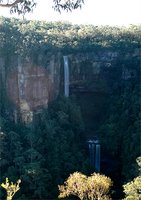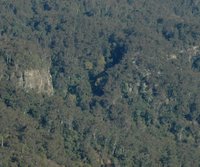Yesterday, my friend Gordon accepted a suggestion from me to
help Dr Michael Hindmarsh, from Gerringong. go to the bottom of Belmore Falls. I had met Michael at the Kiama Community Recognition Awards ceremony on 12 December 2014. He happened to mention that he wanted to find a particular tree below Belmore Falls and I said that I could recommend an excellent Bushwalking guide. I had Gordon in mind, and I put them in contact with eachother.
Naturally enough, their starting-off point was Hindmarsh Lookout. So already you can see there is a lot of history involved.
Naturally enough, their starting-off point was Hindmarsh Lookout. So already you can see there is a lot of history involved.
 |
| Gordon at Hindmarsh Lookout |
As best I can remember, Michael is a 5th generation descendant of the Hindmarsh family who were amongst the first settler in Robertson. These people walked up from the Gerringong area, via Hoddle's
Track, up past Saddleback Mtn and up onto the Barrengrounds Plateau, and on
towards the basalt capped hills of Robertson.
The basalt soil was what these pioneer settlers were seeking to claim under the Robertson Land Act of 1861. More history involved. It was Land Reform, pure and simple. The Squatters hated John Robertson for this breaking of their monopoly on land ownership.
The basalt soil was what these pioneer settlers were seeking to claim under the Robertson Land Act of 1861. More history involved. It was Land Reform, pure and simple. The Squatters hated John Robertson for this breaking of their monopoly on land ownership.
"History
In 1861, the powerful Premier of New South
Wales, John Robertson, was determined to break the long-established monopoly of
the squatter-pastoralists in land-holding in the colony. He forced two Acts
through the Parliament, opening up free selection of Crown land by permitting
any person to select up to 320 acres, on the condition of paying a deposit of
one-quarter of the purchase price after survey, and of living on the land for
three years.
Robertson intended to give poorer purchasers access to land and to increase farming and agricultural development in New South Wales. Great conflicts between the squatters and the selectors ensued, and corruption and scheming in acquiring land became rife."
Source:
Robertson intended to give poorer purchasers access to land and to increase farming and agricultural development in New South Wales. Great conflicts between the squatters and the selectors ensued, and corruption and scheming in acquiring land became rife."
Source:
Anyway,
after their bushwalk to the Barrengarry Creek, below Belmore Falls, Michael and
Gordon came back to Gordon's place, where I was awaiting their arrival.
Lulu was with me, of course, and she really likes Gordon. But she took a shine to Michael too.
In particular, what was really fascinating her was the bloody leech bites on
Michael's legs.
She set about cleaning Michael's legs for him.
This scene reminded me of something I had learnt in Bible Studies, namely Lazarus (the leper, not the one who was raised from the dead) who was licked by stray dogs, which cleaned his wounds.
(Luke 16:19-31) |
| Dogs showed compassion toward Lazarus the beggar, even when people did not. Public domain |





















